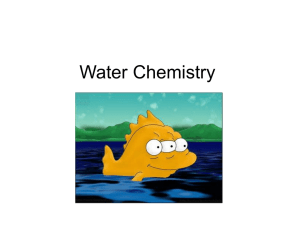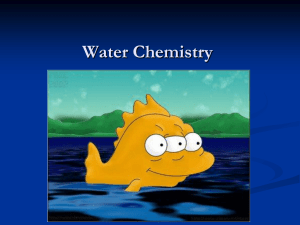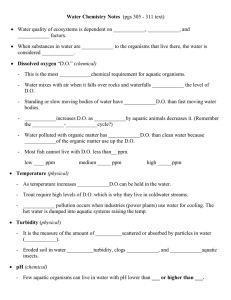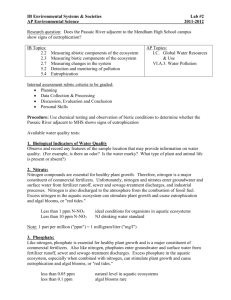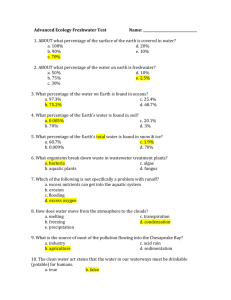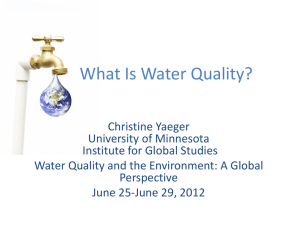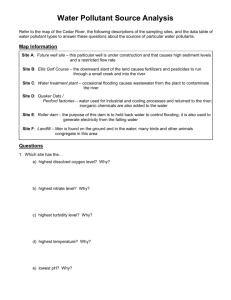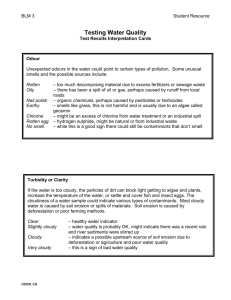Water Chemistry Notes
advertisement
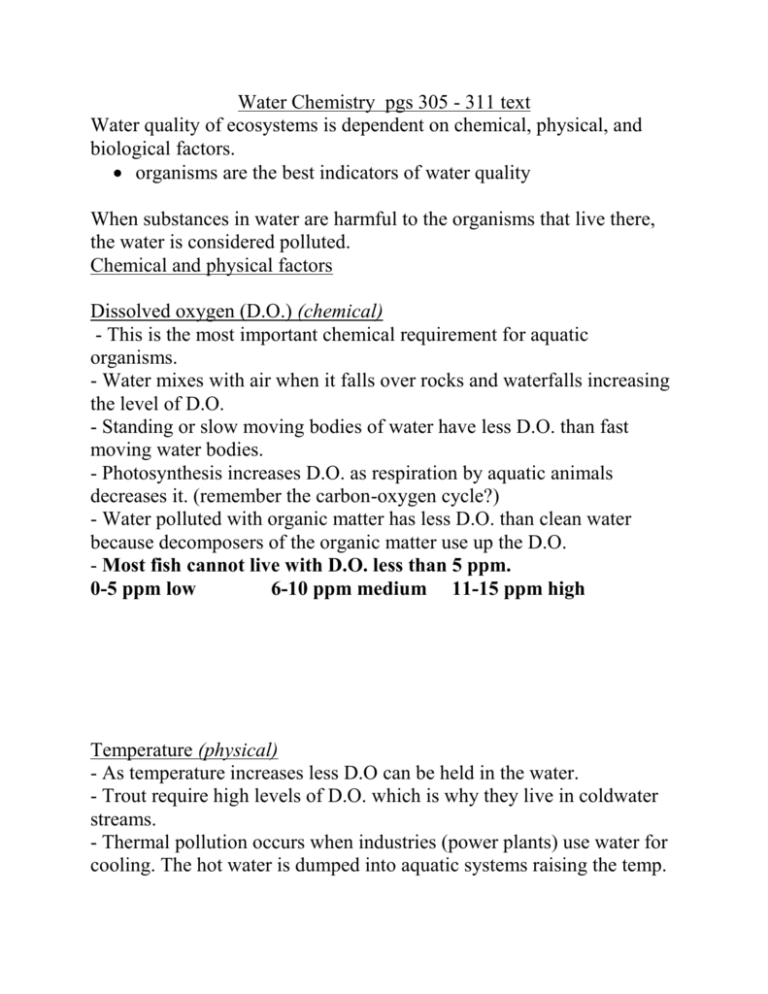
Water Chemistry pgs 305 - 311 text Water quality of ecosystems is dependent on chemical, physical, and biological factors. organisms are the best indicators of water quality When substances in water are harmful to the organisms that live there, the water is considered polluted. Chemical and physical factors Dissolved oxygen (D.O.) (chemical) - This is the most important chemical requirement for aquatic organisms. - Water mixes with air when it falls over rocks and waterfalls increasing the level of D.O. - Standing or slow moving bodies of water have less D.O. than fast moving water bodies. - Photosynthesis increases D.O. as respiration by aquatic animals decreases it. (remember the carbon-oxygen cycle?) - Water polluted with organic matter has less D.O. than clean water because decomposers of the organic matter use up the D.O. - Most fish cannot live with D.O. less than 5 ppm. 0-5 ppm low 6-10 ppm medium 11-15 ppm high Temperature (physical) - As temperature increases less D.O can be held in the water. - Trout require high levels of D.O. which is why they live in coldwater streams. - Thermal pollution occurs when industries (power plants) use water for cooling. The hot water is dumped into aquatic systems raising the temp. Turbidity (physical) - It is the measure of the amount of light scattered or absorbed by particles in water (cloudiness). - eroded soil in water increases turbidity, clog fish gills, and smothers aquatic insects. pH (chemical) Few aquatic organisms can live in water with pH lower than 4 or higher than 9. - Best range: fish 6.7 - 8.6 - CO2 produced from decaying organisms forms carbonic acid decreasing pH. - sulfuric acid in water comes from acid mine drainage and acid rain (burning fossil fuels) decreasing pH. - alkaline industrial waste (bleaching plant) can increase pH. Hardness (chemical) - Water with many minerals is considered hard. - Water containing calcium and magnesium is said to be hard. - The minerals in hard water can buffer acidic rain water. - Calcium is needed for clams, snails, and other shelled organisms. - 0 - 60 ppm soft 60 - 120 med. 120 - 180 hard Nitrates and Nitrites (chemical) - Runoff of fertilizers, animal wastes, and sewage are the major sources. - Excessive nitrogen causes algae population to explode (algae bloom). Eutrophication – when algae dies- bacteria takes out D.O. - Most nitrogen is constantly used up in the system. More than 1 ppm. indicates excess. - When the algae dies it decomposes using up the D.O. - high nitrogen harms animals - causes methemoglobinemia (blue babies) (look it up pg. 311 in text). Phosphates (chemical) - Comes from the same sources as nitrogen as well as some industrial processes. - also causes algae blooms. eutrophication - not as harmful to humans or animals as nitrogen. - More than 0.5 ppm. indicates excess. Water Chemistry pgs 305 - 311 text Water quality of ecosystems is dependent on ________, _______, and __________ factors. When substances in water are harmful to the organisms that live there, the water is considered polluted. Chemical and physical factors Dissolved oxygen (D.O.) (chemical) - This is the most important chemical requirement for aquatic organisms. - Water mixes with air when it falls over rocks and waterfalls increasing the level of D.O. - Standing or slow moving bodies of water have less D.O. than fast moving water bodies. - ________ increases D.O. as _______ by aquatic animals decreases it. (remember the carbon-oxygen cycle?) - Water polluted with organic matter has less D.O. than clean water because __________ of the organic matter use up the D.O. - Most fish cannot live with D.O. less than__ ppm. ____ ppm low _____ ppm medium _____ ppm high Temperature (physical) - As temperature increases ______ D.O can be held in the water. - Trout require high levels of D.O. which is why they live in coldwater streams. - _________pollution occurs when industries (power plants) use water for cooling. The hot water is dumped into aquatic systems raising the temp. Turbidity (physical) - It is the measure of the amount of ______ scattered or absorbed by particles in water (cloudiness). - eroded soil in water increases turbidity, clogs __________, and smothers aquatic insects. pH (chemical) Few aquatic organisms can live in water with pH lower than _ or higher than _. - Best range: fish 6.7 - 8.6 - CO2 produced from decaying organisms forms ______ _____ decreasing pH. - ________ acid in water comes from ______________ and acid rain (burning fossil fuels) decreasing pH. - alkaline industrial waste (bleaching plant) can increase pH. Hardness (chemical) - Water with many minerals is considered hard. - Water containing ________ and ________ is said to be hard. - The minerals in hard water can _______ acidic rain water. - Calcium is needed for ______, _____, and other shelled organisms. - ______ ppm soft __________ med. ________ hard Nitrates and Nitrites (chemical) - Runoff of _________, ___________, and _________ are the major sources. - Excessive nitrogen causes algae population to explode (________________) - Most nitrogen is constantly used up in the system. More than ___ ppm. indicates excess. - When the algae dies it decomposes using up the D.O. - high nitrogen harms animals - causes _________________ (blue babies) (look it up pg. 311 in text). Phosphates (chemical) - Comes from the same sources as nitrogen as well as some industrial processes. - also causes algae blooms. - not as harmful to humans or animals as nitrogen. - More than 0.5 ppm. indicates excess.
